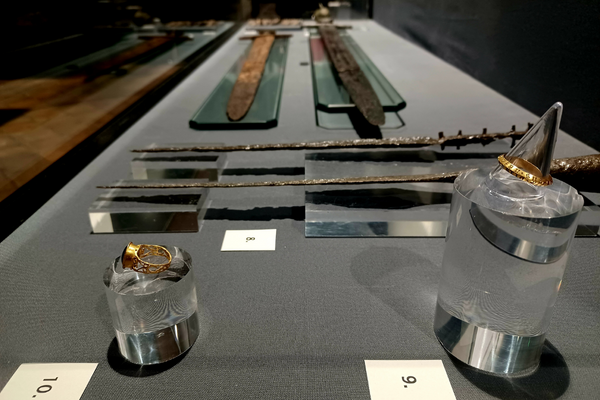
Monday 6 February 2023
An incredible and brutal moment in West Suffolk’s history forms part of the Conflict Exhibition showing at Moyse’s Hall Museum from Saturday 28 January – Sunday 23 April 2023.
Exploring the human lust for power, oppressive regimes, or those seeking to establish the rule of law, the exhibition delves into over 2000 years of human conflict with local, national, and international artifacts included.
The largest known conflict seen near Bury St Edmunds was the ‘Battle of Fornham’, fought across land that includes or borders the villages of Fornham St Genevieve, Fornham All Saints, and Fornham St Martin.
The battle was fought on 17 October during the Revolt of 1173-74. The Revolt was a complex family feud - full of ego and greed; modern soap operas take note!
Read on for an exciting synopsis of the story surrounding one of the most complex feuds in the history of a country full of convoluted conflicts; many aspects of what follows are open for debate…
It has been argued that the Revolt occurred as a result, in part or in total, of Henry II’s decision to offer three castles to his youngest legitimate son John as part of an inheritance to secure his son’s marriage to the daughter of the Count of Maurienne. This undermined the claim of Henry the Young, the king’s eldest legitimate son, as the three castles chosen were on land that would have formed part of his inheritance.
The fallout of this decision would lead to Henry II’s eldest three legitimate sons, Henry, Richard (later ‘The Lionheart’), and Geoffrey, withdrawing to the court of Louis VII and raising a rebellion against their father. Louis was Henry the Young’s father-in-law and encouraged the rebellion along with other nobles who would profit from a transfer of power to the would-be usurper.
The brothers were also aided by their mother, Eleanor of Aquitaine, wife of Henry II, who joined the cause along with many others who were horrified by the King’s possible involvement in the martyrdom of Archbishop Thomas Beckett in 1170, an event which sent shockwaves throughout the Christian world.
The revolt began in April 1173 and would lead to battles throughout the Angevin Empire in England and Normandy. The endeavour was for Henry the Young and Louis VII to aggressively take the formers inheritance and then, perhaps ironically, give land and revenues of it to those nobles who supported the move.
Louis and Henry the Young secured many allies and were confident enough to invade Normandy while Scotland invaded England from the north. These invasions failed, as did the peace talks that followed, which led to further conflict.
October 1173 saw the revolt reach our Suffolk borders. Robert de Beaumont, 3rd Earl of Leicester, invaded England with an army of Flemish mercenaries, landing at Walton, Suffolk. Leicester took his forces to Framlingham where he joined Hugh Bigod, 1st Earl of Norfolk. Bigod was a keen supporter of Henry the Young having been promised the custody of Norwich Castle if the rebellion was victorious.
Robert de Beaumont’s next step was to move his army to his home base of Leicester, with the motive for this being up for debate. One possibility is the need for reinforcements due to fighting with the King’s forces weakening their hold. However, another interesting suggestion is that Leicester had to move on due to frustrations or squabbling with Bigod and his wife, Gundreda, who herself was of the de Beaumont bloodline.
Leicester’s forces were cut off as they were fording the River Lark, and while split between banks were easier prey for supporters of Henry II who rode under the banner of St Edmund, backed by our Abbey. The King’s supporters took the victory and captured Leicester.
On display we have the two swords found at the battle site. The first - looked after by Moyse’s Hall Museum - is on permanent loan from the MacRae family who owned the land it was found upon. The second sword is usually on display at ‘All Saints Hotel’ close to where it was found, with their café overlooking the beautifully kept battlefield. This is the first time the public have been offered the chance to see the swords side-by-side. From the battlefield we also have a dagger and spear, as well as arrowheads and bolts of the period to give a sense of the scene itself.
Two rings were found near the battle site on land near the River Lark. There is a story about Petronilla, wife of the captured Earl of Leicester, who cast a ring into the mud and went into the water. It has been suggested that if true she was trying to drown herself in defeat. While unlikely to be her ring, these two pieces offer a chance to contemplate a moment of humanity within a narrative largely lost to inhuman facts and dates. One is a stunning Roman ring, which, it has been suggested, may have been reused during the Medieval period. The other is probably too late for the battle but nonetheless a beautifully inscribed gold medieval ring.
Come on Netflix, get this crazy business on screen.
Elsewhere in the ‘Conflict’ exhibition you can see the incredible Saxon ‘Snape Sword’, Wellington and Hardy’s signatures, along with incredible artifacts from their era, a Civil War display, and medieval and post-medieval hand-to-hand combat. In a supplementary display we have one of the guns used to kill Bonnie and Clyde. Bringing us right up to the modern era, we have worked with the Suffolk Regiment Museum and the Royal Anglians to display real uniforms from the First and Second World Wars, as well as contemporary military dress.
Sign up to the WOWS mailing list to be among the first to know What's On in West Suffolk by email.